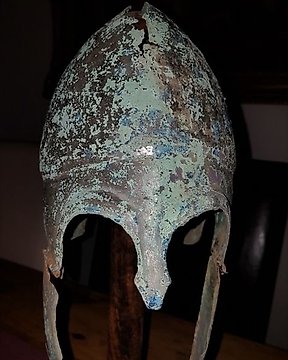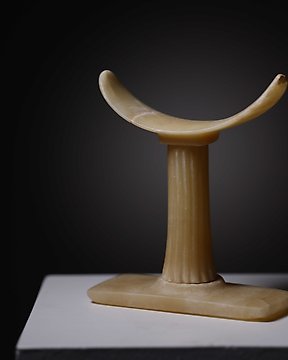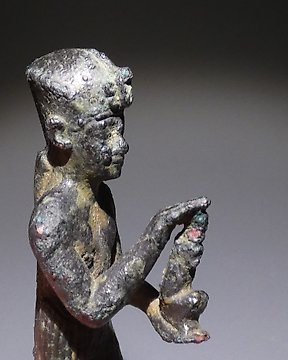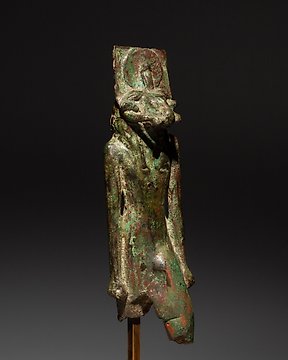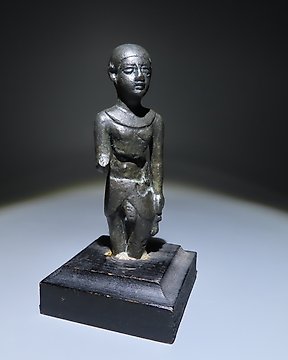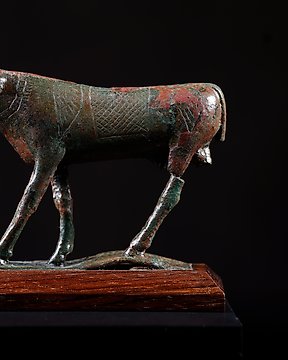
Αρχαία Αιγυπτιακή Μπρούντζος Αιγυπτιακός Apis God Με ισπανική άδεια εξαγωγής - 7 cm
Το Catawiki συνεχώς ενημερώνει την τεχνολογία του. Είστε χρήστης ενός ξεπερασμένου προγράμματος περιήγησης. Για να βελτιστοποιήσετε την εμπειρία περιήγησής σας, παρακαλούμε ενημερώστε το πρόγραμμα περιήγησης.
Μπορείτε να ορίσετε τις προτιμήσεις cookies χρησιμοποιώντας τις παρακάτω εναλλαγές. Μπορείτε να ενημερώσετε τις προτιμήσεις σας, να αποσύρετε τη συγκατάθεσή σας ανά πάσα στιγμή και να δείτε μια λεπτομερή περιγραφή των τύπων cookies που χρησιμοποιούμε εμείς και οι συνεργάτες μας στην μας Πολιτική Cookies.
Αρ. 84074779

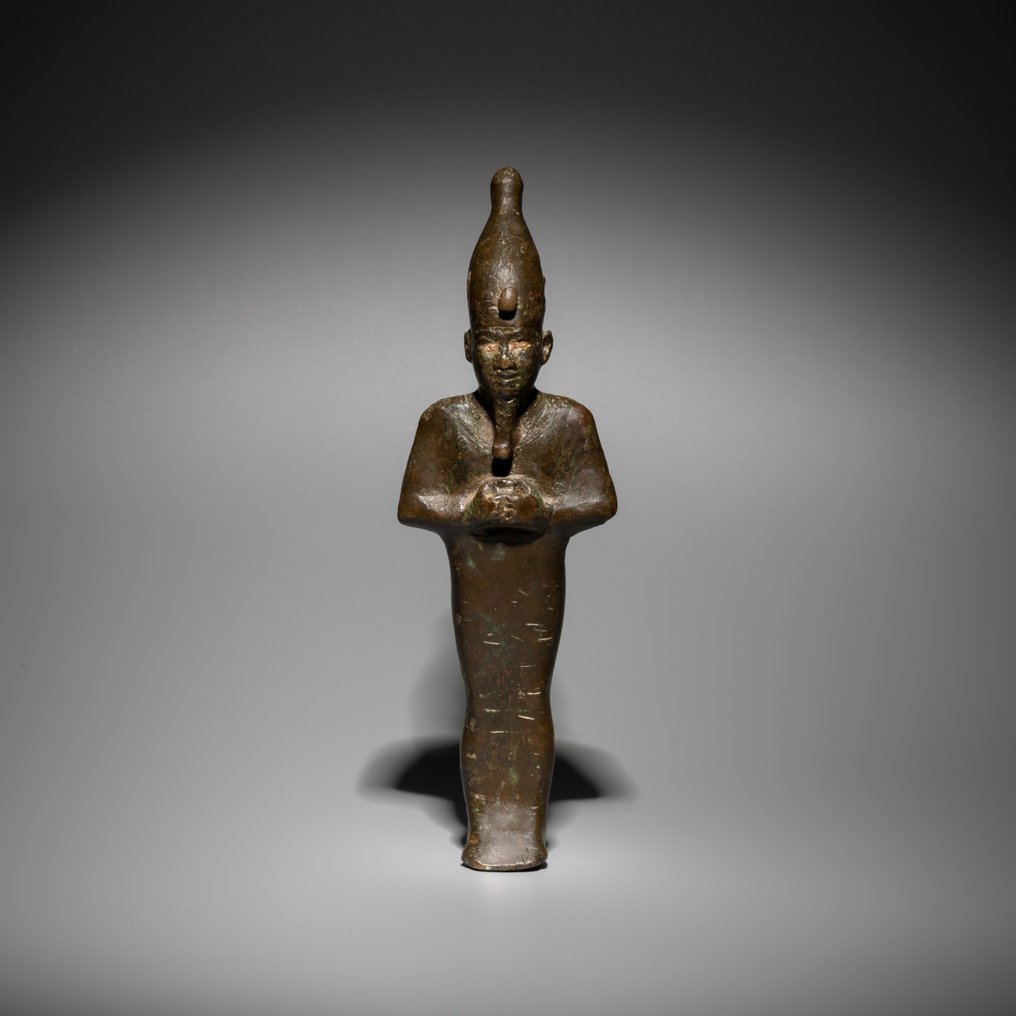

Osiris God
Ancient Egypt, Late Period, 664 - 332 BC
MATERIAL: Bronze
SIZE: Height 15 cm.
PROVENANCE: Private collection, Paris, France. Acquired around the 1980s.
CONDITION: Good condition.
DESCRIPTION:
Originally, the figure of Osiris was linked to the fecundity of the Egyptian soil, the renewal of vegetation and the world of shepherds, as evidenced by the heka sceptre (which reproduces the shepherds’ crook). He embodied the fertile land and the arable fields, and therefore became the guardian of the order of the universe and the cycles of nature. But the most famous myth concerning him is the one in connection with his death, known through many versions: the son of Geb (the earth) and Nut (the sky) and the husband of Isis, the god primarily was a pharaoh. With Isis, they were a pair of royal benefactors who taught mankind farming and fishing (Osiris), weaving and medicine (Isis). Jealous of the sovereign, his brother Seth assassinated him, cut up his body and disposed of the pieces in the Nile. However, Isis, his wife and faithful widow, found and reassembled the body of her husband and, with the help of her sister, Nephtys, and of Anubis, she embalmed the corpse. After breathing life into him for a short instant, Isis was impregnated by Osiris: this union resulted in the birth of Horus, who, following in the footsteps of his father, became Pharaoh. And so, after having survived the ordeal of death, Osiris triumphed thanks to the magic of his wife and became the ruler of the underworld. He represented the seeds of life and, at the same time, was the protector of the deceased, to whom he would promise life after death.
These two closely related characteristics linking the god of fecundity and the funerary divinity were certainly the basis for the success Osiris enjoyed in the Egyptian world: from the New Kingdom on, and especially during the entire 1st Millennium BC, statuettes of Osiris were among the most important funerary offerings.
The technique of lost wax casting is a sculptural procedure using a mould made from a prototype of the piece to be worked, and this prototype is usually made from beeswax. This is covered with a thick layer of soft material, usually clay, which then solidifies. Once this has hardened it is put in a kiln where the wax inside melts and leaks out through expressly made holes in the clay. In its place molten metal is injected and this takes on the exact form of the mould. To release the final piece the mould must be removed.
Notes:
- The piece includes authenticity certificate.
- The piece includes Spanish Export License.
- The seller guarantees that he acquired this piece according to all national and international laws related to the ownership of cultural property. Provenance statement seen by Catawiki.
Osiris God
Ancient Egypt, Late Period, 664 - 332 BC
MATERIAL: Bronze
SIZE: Height 15 cm.
PROVENANCE: Private collection, Paris, France. Acquired around the 1980s.
CONDITION: Good condition.
DESCRIPTION:
Originally, the figure of Osiris was linked to the fecundity of the Egyptian soil, the renewal of vegetation and the world of shepherds, as evidenced by the heka sceptre (which reproduces the shepherds’ crook). He embodied the fertile land and the arable fields, and therefore became the guardian of the order of the universe and the cycles of nature. But the most famous myth concerning him is the one in connection with his death, known through many versions: the son of Geb (the earth) and Nut (the sky) and the husband of Isis, the god primarily was a pharaoh. With Isis, they were a pair of royal benefactors who taught mankind farming and fishing (Osiris), weaving and medicine (Isis). Jealous of the sovereign, his brother Seth assassinated him, cut up his body and disposed of the pieces in the Nile. However, Isis, his wife and faithful widow, found and reassembled the body of her husband and, with the help of her sister, Nephtys, and of Anubis, she embalmed the corpse. After breathing life into him for a short instant, Isis was impregnated by Osiris: this union resulted in the birth of Horus, who, following in the footsteps of his father, became Pharaoh. And so, after having survived the ordeal of death, Osiris triumphed thanks to the magic of his wife and became the ruler of the underworld. He represented the seeds of life and, at the same time, was the protector of the deceased, to whom he would promise life after death.
These two closely related characteristics linking the god of fecundity and the funerary divinity were certainly the basis for the success Osiris enjoyed in the Egyptian world: from the New Kingdom on, and especially during the entire 1st Millennium BC, statuettes of Osiris were among the most important funerary offerings.
The technique of lost wax casting is a sculptural procedure using a mould made from a prototype of the piece to be worked, and this prototype is usually made from beeswax. This is covered with a thick layer of soft material, usually clay, which then solidifies. Once this has hardened it is put in a kiln where the wax inside melts and leaks out through expressly made holes in the clay. In its place molten metal is injected and this takes on the exact form of the mould. To release the final piece the mould must be removed.
Notes:
- The piece includes authenticity certificate.
- The piece includes Spanish Export License.
- The seller guarantees that he acquired this piece according to all national and international laws related to the ownership of cultural property. Provenance statement seen by Catawiki.
